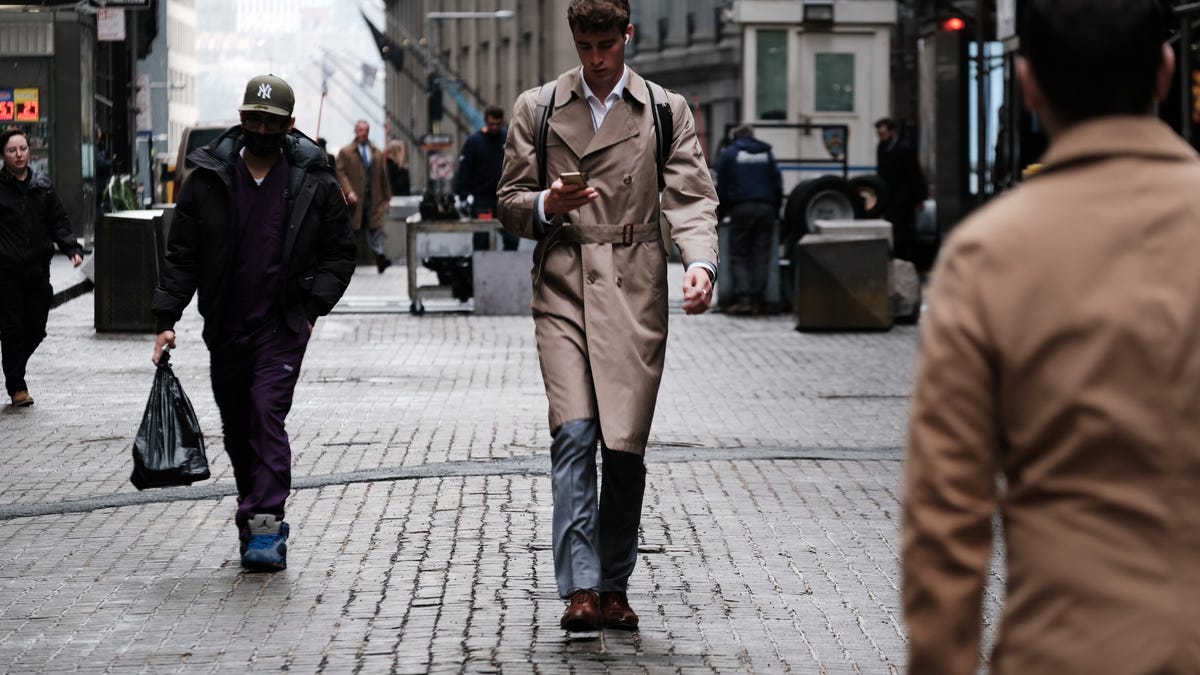New York Using Billboards To Cut Down On Speeding Is Pretty Lame

NEW YORK, NEW YORK – MAY 02: People walk along Wall Street near the New York Stock Exchange (NYSE) on May 02, 2022 in New York City. Photo: Photo by Spencer Platt/Getty Images (Getty Images)
New York is one of the safest cities to bike and walk in, but fatality numbers have been on the rise for a few years now, alarming city officials and safe street activists alike. Part of the city’s plan to reverse the trend involves spending $4 million on a couple of scary billboards in neighborhoods where fatalities are the highest.
Yeah… hmm. From the New York Times:
A new billboard in East New York shows a pedestrian thrown into the air after bouncing off the front of a car, as his coffee splashes everywhere. “Speeding ruins lives,” it says. “Slow down.”
The goal of the campaign is to scare speeding drivers in this Brooklyn neighborhood, where 35 people have been killed in traffic crashes since 2017.
It is part of New York City’s latest effort to battle rampant speeding, which has turned neighborhood streets into raceways and propelled traffic deaths to the highest level in eight years.
The 18 billboards will be scattered through neighborhoods across the five boroughs, like Washington Heights in Manhattan and Jamaica in Queens. The message will also appear on TV ads, public bus stands and gas pumps. City workers will hand out leaflets which just sounds like more litter. This will all go on for eight weeks.
If this sounds like a bit of a dull solution for a sharp rise in fatalities, that’s because it is. Deaths are up across the country as cars get larger and folks drive faster. New York is no exception; drivers killed 64 pedestrians in New York through April 26, up from 60 deaths during the same period last year. Bicyclist deaths are also up. New York is still relatively safe for pedestrians and bicyclists, but that is definitely not the direction you want fatalities to be heading especially after spending millions on Vision Zero, a program meant to eliminate traffic deaths in the city altogether by 2024.
G/O Media may get a commission
45% Off
Shark AI Robot Vacuum
Clean it up
Features incredibly methodical cleaning, has a deep clean feature for big days, is great at getting pet hair, and even comes with a self-emptying base.
Billboards are everywhere, and drivers do take note of the ads we see when we drive. The Arbitron National In-Car Study found that 70 percent of drivers notice billboard messaging at least some of, if not every, time they drive. Are they at all affective? It’s hard to say, but in general, such messages don’t make much of an impression, Kathleen Vohs, a marketing professor at the University of Minnesota, told Marketplace.org:
She added that the same thing applies to any COVID-19 health messages. During the COVID-19 crisis, some highway messages have told people to stay home or to wash their hands.
Vohs said the reason why these messages pop up in the first place is because they are already based on pre-existing social norms.
“Social norms are both an alternate explanation for the success of mass marketing campaigns, and also work hand in hand with them,” Vohs said. “People think, ‘Wow, you can just advertise anything and it will happen.” Sometimes it seems that way, but if you look at the broader social context, you’re like, “Oh, there are a lot of things already pointing that way.’”
I don’t know about you, but the only billboard that has ever made me slow down was one for Honey Baked Hams that went up over Easter years ago. It looked so much like genitals I hit the brakes in wonder at what I was seeing.
Billboards are not cheap, especially in one of the largest markets in the country. The whole campaign will set the city back $4 million. That doesn’t seem like a lot, but it is when you know scaring drivers into behaving well doesn’t usually work. It takes creating safer infrastructure that forces drivers to slow down and share the road that saves lives, as the Times points out:
Some transportation advocates have called on cities to focus more on redesigning dangerous streets, saying that it is not enough to come into a neighborhood and tell drivers not to speed when its streets were essentially built to move traffic as fast as possible.
“It’s a vicious cycle,” said Leah Shahum, the executive director of the Vision Zero Network, a non-profit campaign. “Why is there speeding here? It’s because of the environment we built.”
In East New York, the billboard there will be seen by drivers going through a particularly dangerous intersection at Atlantic and Pennsylvania Avenues, where 167 people — including 154 motor vehicle occupants — were injured in crashes from 2015 to 2019, according to the latest data available.
New York Mayor Eric Adams has pledged to put $904 million into redesigning city streets in the name of pedestrian safety, but he’s only a few months into his first term. The billboards may be ineffective, but at least they are immediate and highly visible evidence to New Yorkers that someone is doing at least something about the risks they face everyday.



